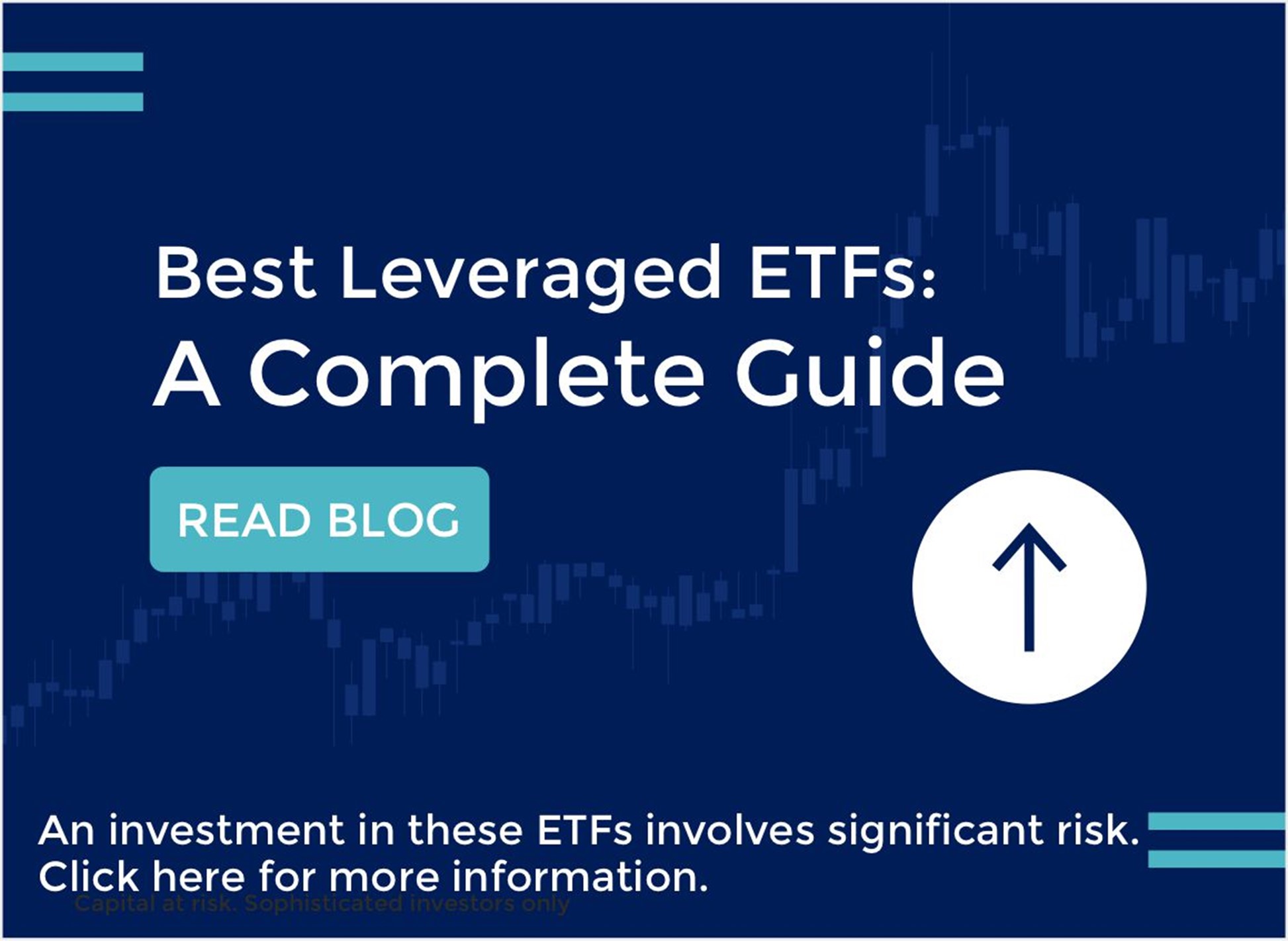Best Leveraged ETFs
Posted:
A leveraged ETF is designed to amplify the daily returns of its underlying asset – whether that’s an index, commodity, collection of stocks and bonds, or a single stock. For example, a 2x TSLA leveraged ETF aims to return twice the daily performance of the underlying asset, which in this case is the single stock of Tesla.
Because of this, leveraged ETFs stand out as a convenient way to get extra exposure to a certain asset. However, the multiplier effect gives them a fair amount of risk, and they should be considered in short-term trading windows by experienced investors.
How Do Leveraged ETFs Work?
The multiplier associated with leveraged ETFs can vary. There are 3x leveraged ETFs on the market, which return three-times the daily performance of the asset it's tied to.
Inverse, or short ETFs also exist, which can be helpful for investors looking to hedge their portfolio or take advantage of the short-term decline of an asset.
The following sections will outline a list of the best leveraged ETFs by GraniteShares in terms of popularity, which includes funds with long and short positions.
List of Leveraged ETFs by GraniteShares
GraniteShares offers a comprehensive list of leveraged ETFs, tracking everything from some of the most popular single stocks (think AAPL, NVDA, TSLA, etc) to commodities and other sector-specific ETFs.
The following sections offer a breakdown of the best leveraged ETFs separated by category and whether they are long or short leveraged funds.
Best Leveraged ETFs: Single Stock (Long)
The following is a list of popular leveraged ETFs that are long and tied to a single stock:
- AMZZ: GraniteShares 2x Long AMZ Daily ETF
- BABX: GraniteShares 2x Long BABA Daily ETF
- AAPB: GraniteShares 2x Long AAPL Daily ETF
- CONL: GraniteShares 2x Long COIN Daily ETF
- FBL: GraniteShares 2x Long META Daily ETF
- MSFL: GraniteShares 2x Long MSFT Daily ETF
- NVDL: GraniteShares 2x Long NVDA Daily ETF
- TSLR: GraniteShares 2x Long TSLA Daily ETF
- TSL: GraniteShares 1.25x Long TSLA Daily ETF
As you can see in the list above, the multiplier (or amount of leverage) tied to these underlying assets can vary. For example, TSL has a multiplier that is 1.25x long of Tesla's stock on a daily basis. Meanwhile, TSLR has more leverage with a multiplier that is 2x long.
Best Leveraged ETFs: Single Stock (Short or Inverse)
The following list includes some short leveraged ETFs that provide leverage opposite the daily performance of the underlying asset:
- NVD: GraniteShares 2x Short NVDA Daily ETF
- TSDD: GraniteShares 2x Short TSLA Daily ETF
- AMDS: GraniteShares 1x Short AMD Daily ETF
These inverse leveraged ETFs are designed to go up when the underlying asset goes down. The opposite is also true, when the underlying asset rises, these funds will drop in value.
For example, AMDS is a 1x short of the ticker AMD. When AMD falls by 1% in a day, the fund is up 1%. The example of TSDD, which is a leveraged 2x short of the ticker TSLA, takes this a step further. When TSLA falls 1% in a day, the fund rises 2% due to the inverse multiple.
Best Leveraged ETFs: Sector Specific & Commodity
There are other leveraged ETFs on the market that are tied to a specific sector, commodity, or index. Here are some examples of those funds:
GraniteShares HIPS US High Income ETF
Known from the ticker HIPS, this fund invests in some of the highest yielding securities spanning across several income categories.
GraniteShares Gold Trust
Identified by the ticker BAR, this gold trust allows investors to gain exposure to gold without having to open a metal account. This can lead to a more cost-efficient acquisition than buying, storing, and insuring physical gold.
GraniteShares Nasdaq Select Disruptors ETF
The ticker for this fund is DRUP, and it selects Nasdaq companies with the highest “disruptive score” and puts them under one umbrella in this ETF. This allows investors to gain access to innovative companies in a convenient and transparent way.
Benefits of Leveraged ETFs
There are plenty of benefits when it comes to leveraged ETFs. These funds can serve as helpful and convenient tools to enhance returns according to your risk tolerance and overall investment strategy.
Higher Return Potential
Due to the multipliers attached to leveraged ETFs, investors have the ability to capture amplified returns in a shorter timeframe while taking advantage of short-term moves in the underlying asset. Of course, this comes with enhanced risks as losses are also subject to the leveraged multiplier effect.
Take Advantage of Bullish & Bear Markets
Inverse ETFs are designed to gain value when the underlying asset declines. This gives investors an opportunity to hedge against market downturns and capture profits even in bear markets.
Convenient Buying & Selling
It’s easy to buy and sell these leveraged ETFs on major exchanges and brokerages. In fact, it’s a similar process as buying and selling single stock during market hours. This is a simple way to gain increased exposure on a position without having to participate in direct short selling or getting approved for a margin account.
Strategies for Investing in Leveraged ETFs
Overall, leveraged ETFs should be used by experienced investors with a well-defined plan of action. There are times when buying and selling leveraged ETFs makes sense for short-term trading windows, which can be a couple of days to a couple of weeks. However, investors should use caution when trading these funds, which require frequent monitoring with strategic entry and exit points.
Understanding the Risks of Leveraged ETFs
While leveraged ETFs offer significant return potential, they also come with unique risks that investors need to understand. These risks are primarily due to the use of derivatives and the daily resetting of leverage.
Volatility Risk
Leveraged ETFs are highly sensitive to market volatility. The daily resetting mechanism can lead to compounding effects that may result in significant deviations from the expected returns over longer periods. For example, in a highly volatile market, even if the underlying asset could end up at the same price after several days, the leveraged ETF might not return to its original value due to daily compounding.
Time Decay
These ETFs are designed for short-term trading, typically within a single day. Holding them for longer periods could lead to time decay, where the performance drifts from the expected multiple of the underlying asset due to the compounding effect of daily returns. This decay could be more pronounced in volatile markets, making leveraged ETFs less suitable for long-term investments.
Risk Management Techniques
There are certain ways to limit risk when buying and selling leveraged ETFs. For one, you can place limit orders and stop-loss orders to control entry and exit points. This reduces overall downside and helps take the emotion out of buying and selling.
On top of that, it’s encouraged to use leveraged ETFs as part of a larger investment plan that includes proper diversification. Position sizing is important to make sure your overall portfolio is not overexposed to risk.
How to Choose the Right Leveraged ETF
Choosing the right leveraged ETF requires careful consideration of several factors to align with your investment strategy and risk tolerance.
Understanding the Underlying Asset
The performance of a leveraged ETF is directly tied to its underlying asset, whether it's a stock, index, commodity, or sector. It's crucial to have a strong understanding of the underlying asset's performance drivers and market conditions. For example, investing in a 2x leveraged ETF for a volatile tech stock like TSLA requires a deep understanding of the stock's market behavior and potential catalysts.
H3 - Assessing the Multiplier
Leveraged ETFs come with different multipliers, such as 2x or 3x. Higher multipliers offer greater potential returns but also increase risk. Assess your risk tolerance and investment horizon to choose an appropriate multiplier. If you are more conservative, a lower multiplier might be more suitable, whereas aggressive traders might opt for higher multipliers to maximize short-term gains.
Common Mistakes to Avoid with Leveraged ETFs
Investing in leveraged ETFs can be rewarding but also risky if not approached correctly. Here are common mistakes to avoid:
Holding for Too Long
One of the most common mistakes is holding leveraged ETFs for longer than the intended short-term period. Due to the daily reset mechanism, holding these ETFs for long might lead to unexpected results that diverge from the expected multiple of the underlying asset's performance.
Ignoring Market Conditions
Leveraged ETFs are more suitable for trending markets rather than volatile or sideways markets. Ignoring the broader market conditions and underlying asset's performance trends can result in significant losses. Always analyze market trends and conditions before investing in a leveraged ETF.
Overexposure
Due to the high-risk nature of leveraged ETFs, it's crucial to avoid overexposure in your portfolio. Diversify your investments and limit the proportion of your portfolio allocated to leveraged ETFs. This helps mitigate risk and prevents large losses in the event of adverse market movements.
Leveraged ETF Case Studies
To provide a practical understanding, let's look at some case studies of popular leveraged ETFs and their performance over specific periods.
Case Study: TSLR - GraniteShares 2x Long TSLA Daily ETF
During a bullish phase for Tesla, TSLR, a 2x leveraged ETF, provided significant returns. For instance, if Tesla's stock rose by 5% in a single day, TSLR would have returned approximately 10%. However, during a volatile phase, the returns could be less predictable due to the daily resetting effect.
Case Study: TSDD - GraniteShares 2x Short TSLA Daily ETF
Conversely, during a bearish phase for Tesla, TSDD, a 2x short leveraged ETF, would benefit from declines in Tesla's stock. If Tesla's stock dropped by 4% in a day, TSDD would increase by approximately 8%. This case highlights how inverse leveraged ETFs can be used to profit from market downturns.
ETFs by GraniteShares
| Product name | Ticker |
|---|---|
|
US |
|
Fund Risk
This website and its content has been provided by GraniteShares.
Investors should consider the investment objectives, risks, charges and expenses carefully before investing. For a prospectus or summary prospectus with this and other information about the Funds, please call (844) 476 8747 or by visting GraniteShares ETFs. Read the prospectus or summary prospectus carefully before investing.
Investing involves risk including the possible loss of principal. There can be no assurance that the investment objective of the Funds will be achieved. None of the Funds should be relied upon as a complete investment program. The investment program of the funds may entail substantial risks.
Exchange-Traded Funds (ETFs) shares trade at market prices rather than at net asset value (NAV), shares may trade at a price greater than NAV (premium) or less than NAV (discount). Shares may be bought and sold throughout the day on the exchange through any brokerage account. Buying and selling shares of ETFs will result in brokerage commissions.
The ETF Funds are distributed by ALPS Distributors, Inc. GraniteShares is not affiliated with ALPS.
ALPS Distributors, Inc, provides marketing services to the Exchange-Traded Grantor Trusts. The Sponsor of the Trust is GraniteShares LLC.
©2024 GraniteShares Inc. All rights reserved. GraniteShares, GraniteShares ETFs, and the GraniteShares logo are registered and unregistered trademarks of GraniteShares Inc., in the United States and elsewhere. All other marks are the property of their respective owners.


